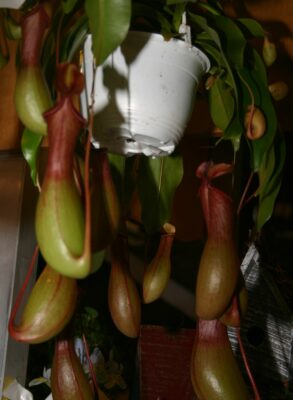
Although most plants convert light energy to chemical energy by photosynthesis, not all obtain the nutrients they need through their roots. Many of those that don’t live in bogs where their roots are permanently in low-nutrient, poorly-drained soil. One adaptation in this environment is obtaining nutrients, especially nitrogen, by digesting insects that visit the plants. In most cases, the insects are caught by leaf adaptations designed to trap and digest them. Among the most well-known of these carnivorous plants are Venus Flytraps, Sundews, and Pitcher Plants. None are easy to grow in a greenhouse, but greenhouse cultivation is possible with the right techniques.
Venus Flytraps have a jaw-like structure at the tip of each leaf which closes tightly over an insect when it touches tiny trigger hairs on the leaf’s inner surface. Enzymes then slowly digest the captured prey. Although the closing of these traps can be fascinating to watch, caring for Venus Flytraps in your greenhouse can be difficult. The plants prefer an environment of high humidity and very acidic and moist soil. A 50/50 mix of peat moss and perlite or sand can work well as a planting medium, as can other low pH mixes. Standard potting soil and coir blends are not recommended. Flytraps also need to be kept warm, 50° to 75°F (10° to 21°C), and given plenty of light, with 8 to 12 hours of sunshine during summer being best. In winter, when daylight is limited, the plants usually go dormant, and the leaves may blacken and fall off. The dormant plants can now be put in a cool location, about 40°F (5°C), awaiting spring. When sunlight and warmth return, the plant leaves usually grow back.
Sundew plants have a different adaptation for catching insects. The upper surface of their leaves has protruding structures informally referred to as tentacles, which are often red in color and which exude a sticky, nectarlike substance that resembles dew glistening in the sun. This is how Sundews got their name and why they are sometimes also called flypaper plants. When an insect touches the sticky tentacle nectar, it becomes stuck, and the tentacles then bend and encircle it. The insect typically drowns in the plentiful nectar surrounding it, after which the plant starts digesting it. Just like Venus Flytraps, Sundews prefer very acidic and moist soil. Although they will grow outside during summer in a sufficiently humid environment, they must be brought indoors in winter and kept where temperatures are no lower than 50°F (10°C) and where insects are still available to them. Regular watering is also needed, and using rainwater is best. The chloride in tap water doesn’t seem to agree with these interesting plants.
One way to grow these plants is in an aquarium tank where their roots can be kept in bog like conditions. An aquarium tank heater may be used to keep the water at the best temperature. Unfortunately, the top of the heater may need to be closed to keep the plants warm which helps keep out insects that might feed the plants. Therefore, an owner will have to figure out the best way to feed the plants the insects they need.
Another group of carnivorous plants are collectively called Pitcher Plants. These have modified leaves that form a vessel-like structure with a pool of liquid at its base, making the name Pitcher very apt. Insects are attracted to nectar at the top and upper inner surface of the pitcher. But lower down, the inner surface becomes very smooth, causing the insect to slide down it into the pool of liquid below from which it can’t escape and therefore drowns. Digestive enzymes then do their work. Growing these plants in a greenhouse entails the same challenges as for Sundews and Venus Flytraps. They too require very acidic and moist soil, high humidity, temperatures in the range of 50° to 70°F (10 to 21oC), ample sunlight, and an adequate supply of insects. Be aware that it’s insects on which all carnivorous plants depend. They can’t digest ground meat or other protein sources, which may actually kill them.


